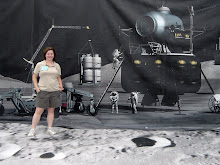Of course, when we arrived here at this huge hole in the ground, like all good adventurers we immediately want to leap into it. But in the trek around Victoria Crater, we've learned tons about the crater and its interior and sharpened our idea of what science can only be done by entring into the crater. For instance, this and other gorgeous Pancam images show that the bottom of the crater is covered with rippled black sand. Big sand dunes are unfriendly rover territory, as exampled by Purgatory Dune where Opportunity was stuck for 5 weeks in 2005. So, driving across the bottom of the crater is right out. But, then we went over to where that dark sand is streaming out of the crater and examined it from a safe vantage point. So we got the science along with the safety in that case.

One of the more visibly fascinating things to see is the rock that makes up the cliff faces of the crater rim, like above in one of my favorite false-color images. We think it is pretty clear that the stuff at the top is normal Meridiani surface rocks, jumbled up as ejecta blocks. But then there's some thin and thick layering, followed by spectacularly crossbedded rocks underneath those. Crossbedding is an indicator of sedimentary processes operating in a fluid environment (here I'm using fluid to mean either wind or water, can't tell which yet) forming dunes and ripples. I was going to try to explain it more, but here's a *fantastic* animation showing how crossbeds form. Though it would be da bomb to drive up to the crossbeds and put the Microscopic Imager right on them, we don't want the rover to tumble to its death extending a giant lever arm on a slope. So, we're doing a lot of what's called superresolution imaging of the cliff faces - taking multiple images from the same location but offset a fraction of a pixel. This allows you to combine the information and subsample below the pixel size, sharpening up edges in the image. We're getting some fantastic views of the stratigraphy this way.
But still, everyone wants to go into the crater, of course! The one thing we can't do anywhere else is understand the relationships between mineralogy, chemistry, texture, and physical properties of the rocks (like hardness or flakiness) in situ. That's why the paved valley of Duck Bay is extra attractive. When Opportunity went into Endurance Crater, we stopped to examine all the rock layers going in, leaving a trail of RAT holes behind. We hope we can do something similar here at Victoria if we get the ok to go in, so stay with us on our trek back!

No comments:
Post a Comment